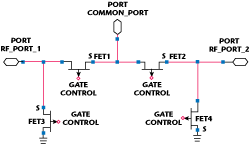Antenna (^.^)
Member level 3
I don't understand how to connect and interface to this switch, AS214-92LF
I've read the data sheet but it didn't help me.
V1 and V2 correspond to the control voltage and I think vcc but which is which?
J1, J2, J3 truth table what does isolation and insertion loss state mean? where is on/off?
Are the control voltages to choose between J1,J2,J3 digital or analogue?
What is the impedance of it? is it 50 ohms?
I've read the data sheet but it didn't help me.
V1 and V2 correspond to the control voltage and I think vcc but which is which?
J1, J2, J3 truth table what does isolation and insertion loss state mean? where is on/off?
Are the control voltages to choose between J1,J2,J3 digital or analogue?
What is the impedance of it? is it 50 ohms?
